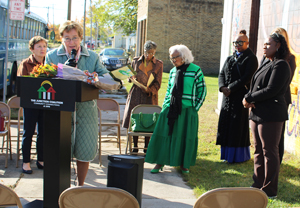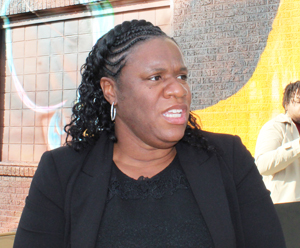
The Truth Staff
The Centers for Disease Control and Prevention (CDC), through its Child Lead Poisoning Prevention Program, has awarded Toledo’s Junction Coalition a $600,000 grant, spanning over a three-year period, to help reduce lead poisoning in the Toledo community. The Junction Coalition is one of 11 organizations in the United States, and the only organization in the state of Ohio, to receive this grant.
Alicia Smith, CEO of the Junction Coalition, announced the grant on Monday morning during a press conference in front of the mural on the side of the Coalition’s office building. Smith was accompanied by representatives of the numerous community organizations that have partnered to bring the grant to Toledo.
“We are honored to be among the distinguished recipients of this grant, a testament to our unwavering commitment to the welfare of Toledo’s residents,” said Smith. “This funding will empower The Junction Coalition to make a lasting impact in Toledo, supporting those most vulnerable to the dangers of lead poisoning.”
 Joining Smith and Congresswoman Marcy Kaptur at the announcement were Angela Mingo, vice president of Development and Corporate Affairs for Nationwide Children’s Hospital; Juanita Greene, co-chair, the Toledo Lead Poisoning Prevention Coalition; George Thomas, CEO and general counsel, The Fair Housing Center and co-chair, the Toledo Lead Poisoning Prevention Center; Doni Miller, president and CEO, Neighborhood Health Association, Theresa M. Gabrial, board chairman, Pathway, Inc. and State Senator Paula Hicks Hudson.
Joining Smith and Congresswoman Marcy Kaptur at the announcement were Angela Mingo, vice president of Development and Corporate Affairs for Nationwide Children’s Hospital; Juanita Greene, co-chair, the Toledo Lead Poisoning Prevention Coalition; George Thomas, CEO and general counsel, The Fair Housing Center and co-chair, the Toledo Lead Poisoning Prevention Center; Doni Miller, president and CEO, Neighborhood Health Association, Theresa M. Gabrial, board chairman, Pathway, Inc. and State Senator Paula Hicks Hudson.
“Today we announced $600,000 in funding to The Junction Coalition to spur on community engagement, educational programming, and ultimately reduce and prevent lead exposure in Toledo. The Center for Disease Control’s Child Lead Poisoning Prevention program supports critical drinking water infrastructure needs, including replacing toxic lead service lines. In Toledo, it will have profound benefits to public health as it reaches among our most historic neighborhoods,” said Congresswoman Marcy Kaptur. “I am glad to have fought alongside our local partners to bring this funding home, and I will continue to support them in their efforts and work to bring more funding home across our region of NW Ohio.”
Kim Baker, who has served in many roles in government and nonprofit circles, such as former aide to Jack Ford when he served on City Council, was named the program coordinator for the three-year rollout of the lead poisoning prevention program
Baker noted that the program will start the prevention efforts in the Junction neighborhood during the first year, encompass the north Toledo community in the second year and take the program to all of Toledo in the third.
“We know that there is no safe level of lead,” said Nationwide’s Mingo as she spoke of the harm caused locally and statewide by the pervasive ness of lead paint in low-income areas and the impact on children in particular.
“This country has suffered for a long time with institutional segregation and lead paint if a consequence,” said NHA’s Miller. “This is the right thing to do and it aligns perfectly with our mission; we are also a civil rights organization and everyone deserves a healthy life.”
Fair Housing’s Thomas spoke of the “hundreds and thousands” of children damaged every year by lead paint poisoning. “This is a major impediment to fair housing in our community with real long-term consequences.”
Thomas noted that the nation’s laws are too often enacted in a reactionary response to harm already inflicted. It’s time, he said, to be proactive in the approach to such a community problem.
“This is a moral issue,” said Toledo Lead Poisoning Prevention Coalition’s Greene. “We are going to be a force in making sure we educate the community.”
Such sentiments were echoed by State Senator Hicks-Hudson who added: “The problem can be prevented if we have the will to do it.”
According to The Toledo Lead Poisoning Prevention Coalition, the Toledo community has inherited a large, toxic legacy of lead paint exposure due to most of Toledo’s housing stock being built before 1978.
Every year, thousands of Toledo children test high for lead in their blood. There is no safe level of lead in the bloodstream. The CDC’s grant, provided by the National Center for Environmental Health’s Lead Poisoning Prevention and Surveillance Branch, was established to help families avoid the dangers of lead in their homes.
